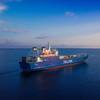Changing Russian Export Patterns
Potentially increasing costs for transporting heavy fuel oil may limit traders taking fuel oil from, for example, the Baltic Sea to the Far East. The Prestige incident has prompted Europe to require heavy oils to be transported to European ports exclusively in double-hull (DH) tankers and in general charterers have become more cautious regarding the tankers they use for HFO. Some oil companies such as Preem, Norsk Hydro and Statoil used only DH tankers for HFO even before the Prestige accident. In the past HFO has in general largely been transported in single-hull/old tankers by traders, but even traders are to a great extent dependent on acceptance by the major oil companies. FSU petroleum is transported through sensitive areas such as the narrow Sounds between the Baltic Sea and Kattegatt, the Bosphorus Straits and from the Russian Barents Sea. IEA has indicated that tightening safety procedures in the Bosphorus Straits may restrict Black Sea export traffic. However, in 2005 the pipeline from Baku to Ceyhan will start to take market share from tankers from the Black Sea. The Baltic export share has increased from 23% in 1994 to 36% in July 2003. It is the pipeline share that has declined from 34% in 1994 to 17% January to July 2003, which means that the seaborne share has increased from 66% to 81%. Petroleum Intelligence Weekly (PIW) reports that expansions promise to make the Baltic Sea a more important export hub for Ural crudes than the Black Sea ports, principally Novorossiysk. Capacity upgrades will boost Baltic loading capacity by another 0.36m bd by the end of this year, with 0.24 mbd more at Primorsk and another 0.12 mbd being added by Yukos at the Lithuanian port of Butinge. Potentially, this could increase the traffic in Ural crudes from Northwest Europe to West Mediterranean destinations. Refiners in Spain and Portugal already take occasional cargoes from NW Europe when they are unable to source Mediterranean cargoes with suitable loading dates. Russia's flagship expansion project - the Baltic Pipeline System (BPS) to the port of Primorsk - is developing rapidly, with 0.12 mbd of new capacity brought on line last month, raising potential throughput to 0.36 mbd. A target capacity of 0.84 mbd via Primorsk is set for March 2004. According to PIW, pipeline operator Transneft even has plans to boost BPS to 1.1 mbd, elevating Primorsk over the main Black Sea port of Novorossiysk as the number one export outlet. Russia's focus on increasing export capacity out of the Baltic Sea is of little surprise, given the notorious weather-related loading delays, particularly in the winter, in the Black Sea as well as Turkey's shipping restrictions in the Bosphorus. Ural crude oils face increasing competition in the Mediterranean from rising Algerian and Caspian output as well as from Iraqi Kirkuk oil from Ceyhan when it eventually comes back on stream. The disadvantages of the Baltic are the winter ice restrictions and the draught restrictions in the Straits of Denmark that limit vessel sizes to around 110,000 dwt. Novorossiysk, by comparison, can load vessels of up to 150,000 dwt. Source: INTERTANKO











